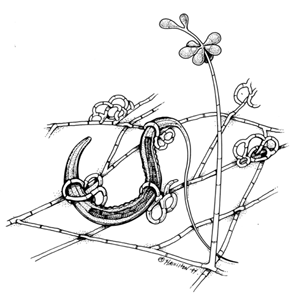
Ecology of Parasites

Field course
Ometepe Biological Field Station
Summer 2001 session #2
Dr. Jacqueline Bird
Department of Biology
Hillcrest Trail
Northern Michigan University
Marquette, MI 49885-2310
(906) 227-1586
E-MAIL ADDRESS: jbird@nmu.edu
Ecology of parasites Field course:
This course is designed for upper level undergraduates interested in parasitology. Emphasis will be placed on ecology and epidemiology of common parasites in domestic and wild animals. Students should have a background in zoology and ecology. The courses will include classroom lectures, collection of field specimens and their analysis by common laboratory diagnostic techniques, reading assignments, discussion of reading and field notes, and individual research projects. Students will present research in a professional style seminar at the end of the course.
The first 2 weeks, students will learn
1. about some of the groups of parasites and
2. how to determine the infection status of animals through fecal analyses.
The last 2 weeks, students will design and conduct their own small studies.
Outline:
- Principles of parasitology.
- Parasite ecology.
- Epidemiology of parasitic diseases.
- Parasite evolution.
- Intro to some Parasites
- Phylum Apicomplexa
- Coccidia from fecal samples.
- Malaria organisims.
- Phylum Ciliophora
- Balantidium coli in pigs' feces.
- Ichthyophthirius multifiliis in fish.
- Class Trematoda - digeneans
- Snail intermediate host squash prep.
- Fasciola hepatica from fecal samples.
- Paragonimus mexicanus cysts in freshwater crabs.
- Class Cestoidea
- Taenia spp.
- saginata.
- solium
- Echinococcus granulosus
- Phylum Nematoda
- Family Trichuridae
- Trichuris spp. from pigs.
- Capillaria spp. from dogs, cats.
- Trichinella spp.
- Family Ancylostomidae
- Necator americanus.
- Ancylostoma spp. from dogs.
- Family Strongylidae
- Large strongyles from horses.
- Small strongyles from horses.
- Family Trichostrongylidae
- Haemonchus spp. in sheep/goats/cattle.
- Ostertagia spp. in sheep/goat/cattle.
- Family Ascarididae
- Ascaris suum from pigs.
- Toxocara spp. from dogs.
- Family Oxyuridae
- Oxyuris equi from horses.
- Syphacia spp. in rats and mice.
- Family Onchocercidae
- Onchocerca volvulus.
- Dirofilaria immitis.
- Phylum Acanthocephala in fishes.
- Orders Mallophaga and Anoplura
- Pigs.
- Birds.
- Dogs.
- Order Siphonaptera
- Dogs.
- Flea traps with green-yellow filters.
- Order Diptera
- Mosquitoes.
- Screw worm.
- Subclass Acari
- Ticks.
- Mites.
- Techniques.
- Qualitative fecal flotation.
- Quantitative fecal egg count.
- Baermann technique.
- Fecal culture.
- Direct smear.
- Necropsy.
- Sedimentation
Required stuff:
Text book: Foundations of Parasitology 6th edition. L. Robers and J. Janovy, Jr.
Latex or plastic gloves
Plastic baggies for collecting fecal samples
20 Plastic 6 oz cups for lab use
dissection kit

Write to La Suerte | La Suerte Home
Page©Copyright 1995 - 1999, La Suerte Biological Field Station



